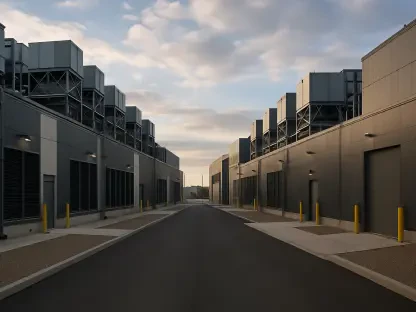Stockton Council has been hard at work reducing its carbon emissions with a focus on achieving net zero by 2032. Since 2010, their initiatives have led to a significant 75% reduction in carbon emissions. This article delves into the progress made so far, the strategies implemented, and the hurdles the council needs to overcome to reach its ambitious target.
Progress and Achievements
The council’s efforts to cut down carbon emissions are impressive, recording a more than 75% reduction since 2010. The most substantial decline in emissions occurred during the COVID-19 pandemic. Various measures contributed to this success, including the installation of solar panels, which are now prominently featured on structures like the new council headquarters, Dunedin House in Thornaby. These solar panels have been instrumental in reducing the reliance on non-renewable energy sources, marking a significant step toward sustainability.
Moreover, the council has incorporated recycling facilities, developed flood alleviation projects, and constructed zero-carbon buildings such as Billingham South Primary School. These initiatives have propelled Stockton Council toward its net zero goal, showcasing effective strategies in emission management. By integrating green technologies and sustainable practices into everyday operations, the council has set a robust foundation for future environmental efforts. The focus on flood alleviation also highlights a pressing concern for many regions worldwide, demonstrating the importance of mitigating climate change effects.
Challenges and Investment Needs
Despite these achievements, Stockton Council acknowledges that significant hurdles remain on the path to net zero emissions by 2032. One prominent challenge is the high carbon emissions associated with residential care homes. Reducing these emissions requires substantial additional investment to ensure continued progression towards the target. The demand for not only financial but also technological and operational investments is a critical aspect that the council must address to continue its positive trajectory.
The challenge extends further into property construction and waste collection and recycling sectors. These areas have been identified as top carbon emitters within the council’s supply chain in the previous financial year, signaling the complexity involved in further reducing carbon output in these sectors. Addressing these issues necessitates a multi-faceted approach, including behavioral changes, technological advancements, and strategic funding allocations. It is clear that without a sustained and concentrated effort in these domains, the council’s overall progress might stall, potentially jeopardizing the achievement of the 2032 goal.
Renewable Energy and Carbon Sources
Renewable energy plays a pivotal role in the council’s strategy, with current efforts generating enough power for approximately seven hours of computer use per worker each week. However, a notable increase in solar panel installations is necessary to power the entire council workforce, estimated to require a football pitch’s worth of solar panels. This scale highlights the substantial infrastructure investment needed to transition fully to renewable energy sources, emphasizing the importance of long-term planning and investment.
The council’s carbon sources are spread across various activities, with gas usage accounting for 34% and fuel use constituting 32%. Notably, only 3% of the council’s vehicles are electric, which lags behind other local authorities who have made more significant strides in decarbonizing their fleets. Recognizing this shortfall is crucial for informed policy changes and investment in electric vehicle infrastructure, which will be essential for the long-term sustainability of the council’s fleet and operations. The shift towards greener energy sources and transportation methods will be a defining factor in meeting the ambitious net-zero target.
New Strategies and Funding
In response to current shortfalls, the council adopted an environmental sustainability and carbon reduction strategy in 2022. This strategy is comprehensive, outlining goals not only to achieve net zero greenhouse gas emissions but also to protect the natural environment, use resources efficiently, and adapt to climate change impacts. The multi-dimensional approach outlined in the strategy signifies the council’s commitment to holistic environmental stewardship, encompassing a broad range of sustainability objectives beyond mere carbon reduction.
To meet these multifaceted aims, council officers are actively developing new climate-change-related schemes. They are considering the allocation of funds from a £20m investment fund designed to transform services, recognizing that further capital investment will be essential to achieve the desired carbon reductions. The ongoing development of innovative schemes and the strategic deployment of financial resources illustrate the council’s proactive stance in overcoming obstacles and ensuring sustained progress toward their environmental goals. The focus on diverse initiatives also underlines the complex nature of achieving net zero emissions, necessitating coordinated efforts across various sectors and activities.
Fleet Performance and Residential Care
Councillor Clare Besford, the cabinet member for environment and transport, acknowledged the substantial progress while expressing concern about the potential stagnation in carbon reduction. Residential care homes emerged as surprising high emitters, necessitating collaborative efforts to curb their emissions. Targeting these high-emission areas requires specialized strategies, investments, and possibly new partnerships between the council and care facility operators to achieve substantial emission reductions.
Council leader Cllr Bob Cook echoed these sentiments, emphasizing the importance of addressing fleet performance and collaborating with local businesses, especially in the petrochemical industry. He highlighted the necessity for these businesses to engage in carbon capture programs to reduce their carbon footprint and avoid potential future carbon-related taxes. The engagement of the private sector, particularly major industrial players, will be crucial for the region’s overall success in cutting emissions, as it requires coordinated and concerted efforts from both public and private entities.
Leading by Example and Future Goals
The Stockton Council has been diligently working to reduce its carbon emissions, focusing on attaining net-zero by 2032. Since 2010, the council’s initiatives have successfully cut carbon emissions by an impressive 75%. This significant reduction demonstrates the council’s commitment to addressing climate change and improving environmental sustainability. This article explores the progress made so far, detailing the various strategies that have been implemented, such as energy-efficient buildings, increased use of renewable energy sources, and sustainable transportation options. Additionally, the article discusses the challenges that lie ahead for the council in its quest to fully achieve its ambitious target, such as securing adequate funding, engaging the community, and fostering collaboration with businesses and other stakeholders. The council’s journey serves as a model for other municipalities aiming to make a substantial impact on reducing their carbon footprint and promoting a greener future.









